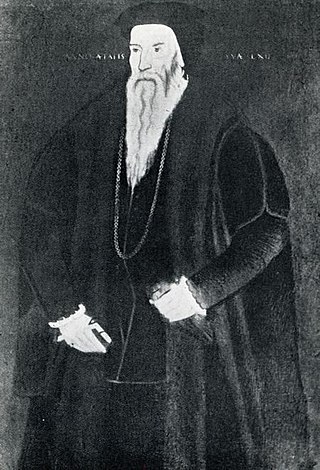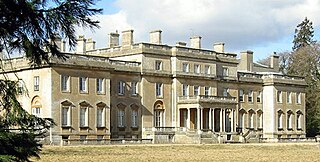
Sir William Esturmy (died 1427 [1] ) (aliasSturmy), of Wolfhall, Wiltshire was an English Knight of the Shire, Speaker of the House of Commons, and hereditary Warden of the royal forest of Savernake, Wiltshire.

Sir William Esturmy (died 1427 [1] ) (aliasSturmy), of Wolfhall, Wiltshire was an English Knight of the Shire, Speaker of the House of Commons, and hereditary Warden of the royal forest of Savernake, Wiltshire.
He was born in about 1356, the son of Geoffrey Sturmy (d. 1381) and nephew and heir of Sir Henry Sturmy of Wolfhall in the Savernake Forest, Wiltshire.
He succeeded his uncle in 1381 which brought him manors throughout Wiltshire, including Elvetham in the north of the county, where he created a 300-acre park, and Wolfhall and other manors in the east. He was knighted by October 1388. He held the post of hereditary warden of Savernake Forest from 1381 to 1417 and from 1420 until his death in 1427.
Between 1384 and 1422 he served as knight of the shire eight times for Wiltshire, twice for Hampshire (1384 and 1390) and twice for Devon (1391 and 1404). He was elected Speaker of the House of Commons in 1404 during the reign of King Henry IV, known as the Illiterate or Unlearned Parliament because the king forbade lawyers from attending. [2] He was appointed High Sheriff of Wiltshire for 1418–19.
He held a number of public commissions and served several times as an ambassador abroad.
He married Joan Crawthorne, the widow of Sir John Beaumont of Shirwell and Saunton in North Devon, by whom he had no sons, only two daughters and co-heiresses including:
He died at Elvetham in 1427 and was buried at Easton Priory near Wolfhall. His heirs were his daughter Agnes (the wife of John Holcombe) and John Seymour (the son of Maud).

Sir John Seymour, Knight banneret was an English soldier and a courtier who served both Henry VII and Henry VIII. Born into a prominent gentry family, he is best known as the father of Henry VIII's third wife, Jane Seymour, and hence grandfather of king Edward VI of England.

Easton Royal is a village in the civil parish of Easton in Wiltshire, England, about 3 miles (5 km) east of Pewsey and 5 miles (8 km) south of Marlborough. The village was the location of Easton Priory from 1234 to 1536. The village mistakenly gained the Royal suffix in 1838 and the name Easton Royal has been in general use since the 1850s.

Seymour, Semel or St. Maur, is the name of an English family in which several titles of nobility have from time to time been created, and of which the Duke of Somerset is the head.

Savernake Forest stands on a Cretaceous chalk plateau between Marlborough and Great Bedwyn in Wiltshire, England. Its area is approximately 4,500 acres.

John Stourton, 1st Baron Stourton of Stourton, Wiltshire, was an English soldier and politician, elevated to the peerage in 1448.


Sir Maurice Russell, JP of Kingston Russell, Dorset and Dyrham, Glos. was an English gentleman and knight. He was a prominent member of the Gloucestershire gentry. He was the third but eldest surviving son and heir of Sir Ralph Russell (1319–1375) and his wife Alice. He was knighted between June and December 1385 and served twice as Knight of the Shire for Gloucestershire in 1402 and 1404. He held the post of Sheriff of Gloucestershire four times, and was Coroner and Justice of the Peace, Tax Collector and Commissioner of Enquiry. His land holdings were extensive in Gloucestershire, Somerset, Dorset, Berkshire and Buckinghamshire. He was descended from an ancient line which can be traced back to 1210, which ended on the death of his son Thomas, from his second marriage, as a young man without male issue. Most of his estates, despite having been entailed, passed at his death into the families of his two daughters from his first marriage.

Sir John Seymour of Wulfhall in Savernake Forest, Wiltshire, feudal baron of Hatch Beauchamp in Somerset, England, was a Member of Parliament.

John Seymour of Wulfhall, of Stalbridge, of Stinchcombe and of Huish, all in Wiltshire, England, was warden of Savernake Forest and a prominent member of the landed gentry in the counties of Wiltshire, Somerset and Dorset. He was the grandfather of Jane Seymour, the third wife of King Henry VIII, and was thus great-grandfather of King Edward VI.

Sir Philip Courtenay, of Powderham, Devon was the fifth son of Hugh Courtenay, 10th Earl of Devon (1303–1377). He was the founder of the cadet dynasty known as "Courtenay of Powderham", seated at the manor of Powderham, until then a former Bohun manor of little importance, whilst the line descended from his elder brother, the Earls of Devon of the mediaeval era, continued to be seated at Tiverton Castle and Okehampton.

Sir Hugh I Courtenay, of Haccombe in Devon, was Sheriff of Devon for 1418/19 and was thrice elected knight of the shire for Devon in 1395, 1397 and 1421. He was a grandson of Hugh de Courtenay, 2nd/10th Earl of Devon (1303–1377), was the younger brother of Edward de Courtenay, 3rd/11th Earl of Devon (1357–1419), "The Blind Earl", and was the grandfather of Edward Courtenay, 1st Earl of Devon (d.1509), KG, created Earl of Devon in 1485 by King Henry VII. He was the link between the senior line of the Courtenay Earls of Devon made extinct following the Battle of Tewkesbury in 1471 and the post-Wars of the Roses creation of a new Earldom for his grandson made in 1485 by King Henry VII.

Guy Bryan, 1st Baron Bryan, KG was an English landowner, military and naval commander, courtier, diplomat, and administrator.

Popham is a hamlet and civil parish south of Basingstoke, Hampshire, England. According to the Post Office the population of the 2011 Census was included in the civil parish of Dummer. The area was occupied from pre-historic times and was established as a permanent habitation during the Roman occupation of Britain. The manor of Popham was established by the monastery of Winchester as an outlying agricultural grain station. A small church and school were later established, but have long since disappeared. The parish and hamlet were later dissected by the M3 Motorway and A303 trunk road. Although named for Popham, Popham Airfield and the Popham Little Chef restaurant are situated in the neighbouring parish of Steventon.
Sir Richard Arches, of Eythrope, in the parish of Waddesdon, Buckinghamshire, was MP for Buckinghamshire in 1402. He was knighted before 1401.
Sir John Roches (c.1333–1400), of Bromham, Wiltshire, was an English admiral, diplomat, magistrate and politician.

Tidcombe is a small village in Wiltshire, England, on the eastern edge of the county, near Hampshire, about 9 miles (14 km) southeast of Marlborough and 7 miles (11 km) southwest of Hungerford. With few inhabitants, it forms part of the civil parish of Tidcombe and Fosbury, which has a parish meeting.

The feudal barony of Hatch Beauchamp or honour of Hatch Beauchamp was an English feudal barony with its caput at the manor of Hatch Beauchamp in Somerset. The site of the mediaeval manor house, to the immediate south of the ancient parish church of St John the Baptist, is today occupied by Hatch Court, a grade I listed mansion built in about 1755 in the Palladian style.

Elvetham Hall is a hotel in Hampshire, England, in the parish of Hartley Wintney about 2 miles (3 km) northwest of Fleet. The building is a High Victorian Gothic Revival English country house and a Grade II* listed building. It stands in a landscaped park that is Grade II listed.

The Savernake Horn is a horn made of 12th-century elephant ivory decorated with 14th century enamelled silver gilt mounts; it has belonged to the Seymour family since at least the Elizabethan period, and is associated with Savernake Forest in Wiltshire, England. It is an olifant/oliphant horn, a hunting horn made from an elephant (olifant) tusk, and is also known as the "Bruce Horn" as it was presented to Thomas Lord Bruce. It is kept in the British Museum.

The Church of Saint Mary the Virgin is the parish church of Great Bedwyn, Wiltshire, England, and a Grade I listed building. The church was built in the Norman style in the 12th century, but beneath the existing building are Saxon remains dating back to the 10th century. The church boasts a handsome memorial to Sir John Seymour, father of King Henry VIII's wife Jane Seymour, and grandfather of King Edward VI of England.